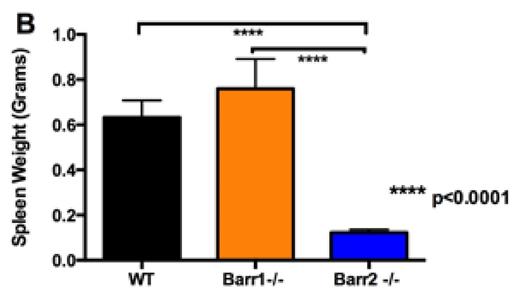Abstract
Background:
Primary myelofibrosis (PMF) is a BCR-ABL negative myeloproliferative neoplasm (MPN) characterized by proliferation of myeloid cells and secondary development of marrow fibrosis due to release of growth factors from clonally expanded cells. PMF is characterized by mutations such as JAK2V617F and MPLW515L that lead to cytokine-independent cell growth and constitutive activation of downstream signaling pathways.β-arrestins are multifunctional adaptor proteins that have been identified as mediators of distinct G protein-coupled receptor signaling cascades independent of G proteins. One isoform, β-arrestin2 (βarr2), has been shown to mediate anti-apoptotic signaling and has been implicated in initiation and progression of another MPN, chronic myeloid leukemia. It is also known that long-term hematopoietic stem cell self-renewal may be dependent on βarr2-mediated signaling with significant defects noted in conditions of increased cellular stress. Based on these observations, we hypothesize that βarr2 plays a causal role in the pathogenesis of PMF by mediating anti-apoptotic signaling and cell proliferation and may serve as a therapeutic target in this disease.
Methods:
We used a standard murine retroviral transduction system to model MPLW515L mutant PMF. KLS cells (Lin-, Sca-1+, c-kit+) were harvested from marrow of donor wild type (WT), β-arrestin1 knockout (βarr1-/-), and β-arrestin2 knockout (βarr2-/-) mice (CD45.2). KLS cells were retrovirally transduced with MSCV-MPLW515L-IRES-GFP and were subsequently injected retro-orbitally into lethally irradiated congenic WT recipient mice (CD45.1). Mice were monitored for leukemia development including splenomegaly and were subject to weekly blood analysis including complete blood counts and flow cytometry for donor cells present in recipient mice. Primary endpoint measured was survival. To elucidate potential pathogenic mechanisms, we harvested KLS cells from marrow of WT, βarr1-/-, and βarr2-/- mice, cultured in vitro and subjected cells to no treatment versus treatment with MPLW515L mutant retrovirus. [3 H]-Thymidine incorporation was performed to assess proliferation and cells were stained for annexin V and propidium iodide (PI) to assess apoptosis.
Results:
In total, twelve mice each received WT or βarr1-/- donor cells and sixteen mice received βarr2-/- donor cells. Survival of mice receiving βarr2-/- donor cells was dramatically improved compared to mice receiving WT or βarr1-/- donor cells by log-rank (Mantel-Cox) test (p<0.0001). One of sixteen mice who received βarr2-/- cells died by the end of the study period compared to 11/12 and 12/12 mice who received WT or βarr1-/- cells respectively (Figure 1A). Mice who received βarr2-/- cells had lower white blood cell counts over time as well as smaller spleens at death measuring 0.12 ±0.013 grams versus 0.63 ± 0.08 grams or 0.76 ± 0.13 grams for mice receiving WT or βarr1-/- cells respectively (p< 0.0001, one-way ANOVA) (Figure 1B).
Increased cell proliferation was observed in KLS cells treated with mutant MPLW515L retrovirus compared to no treatment as assessed by thymidine incorporation. No statistically significant differences in proliferation among WT, βarr1-/- and βarr2-/- cells treated with MPLW515L mutant retrovirus were observed. Increased apoptosis was observed in KLS cells treated with mutant MPLW515L retrovirus compared to no treatment as assessed by annexin V staining in all genotypes. βarr2-/- MPLW515L mutant treated KLS cells demonstrated increased apoptosis at 12.54 ± 0.79 percent compared to untreated KLS cells at 7.22 ± 0.73 percent (p < 0.01, one-way ANOVA) as well as compared to WT treated (p <0.05, one-way ANOVA) and untreated controls (Figure 2).
Conclusions:
These data demonstrate that βarr2 is necessary for development of MPLW515L mutant PMF. Absence of βarr2 does not affect proliferation although it does lead to increased apoptosis in conditions of increased cell proliferation or stress. Hematopoietic cells lacking βarr2 are more prone to apoptosis when subject to the increased cellular proliferation observed in MPNs. βarr2 may therefore be an attractive potential therapeutic target in PMF.
βarr2 is necessary for the development of MPLW515L mutant PMF in a murine model. (A) Kaplan-Meier survival curve. (B) Spleen size at death.
βarr2 is necessary for the development of MPLW515L mutant PMF in a murine model. (A) Kaplan-Meier survival curve. (B) Spleen size at death.
βarr2-/- KLS cells show increased apoptosis versus controls by annexin V and PI staining.
βarr2-/- KLS cells show increased apoptosis versus controls by annexin V and PI staining.
No relevant conflicts of interest to declare.
Author notes
Asterisk with author names denotes non-ASH members.




This feature is available to Subscribers Only
Sign In or Create an Account Close Modal